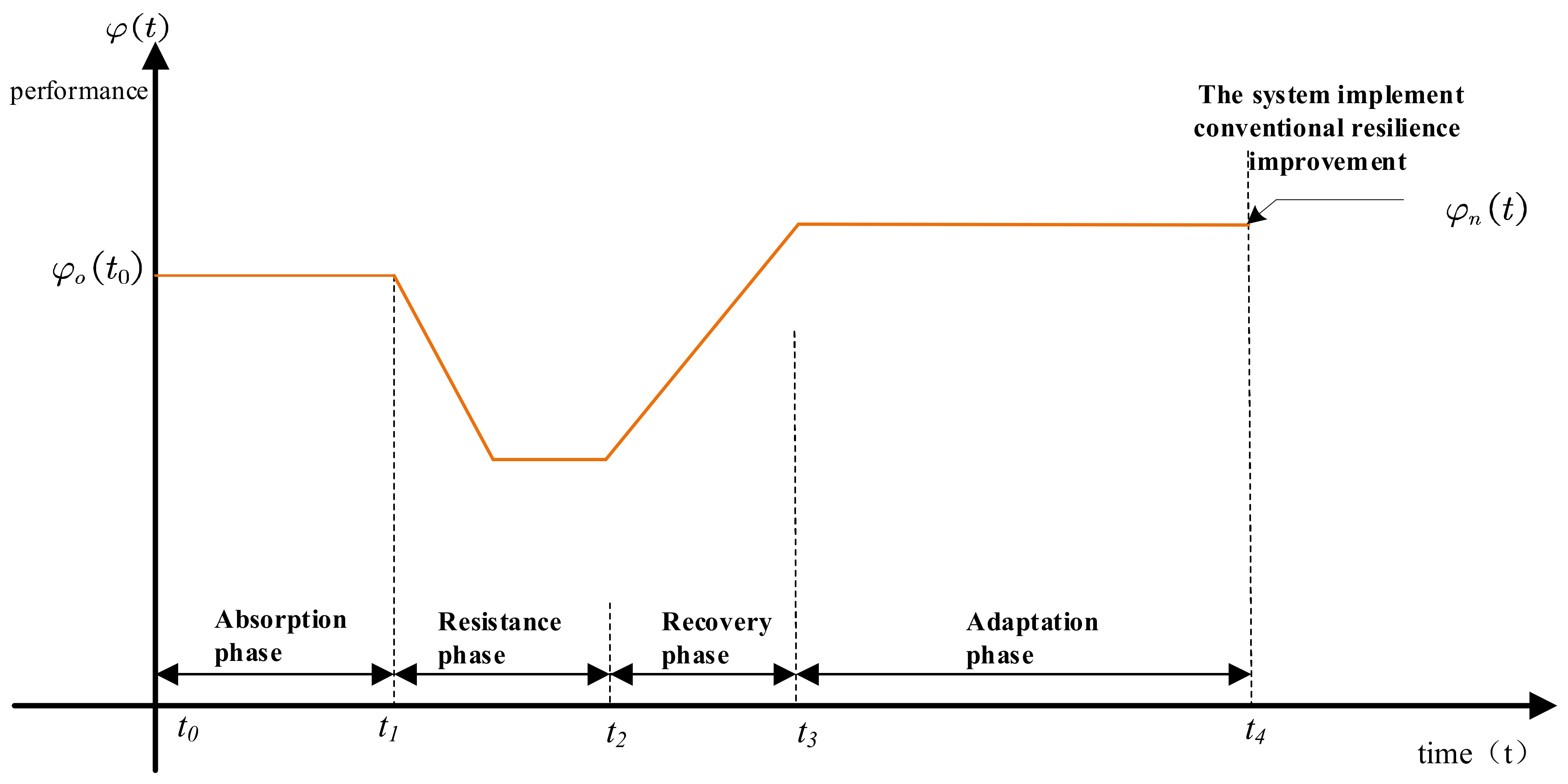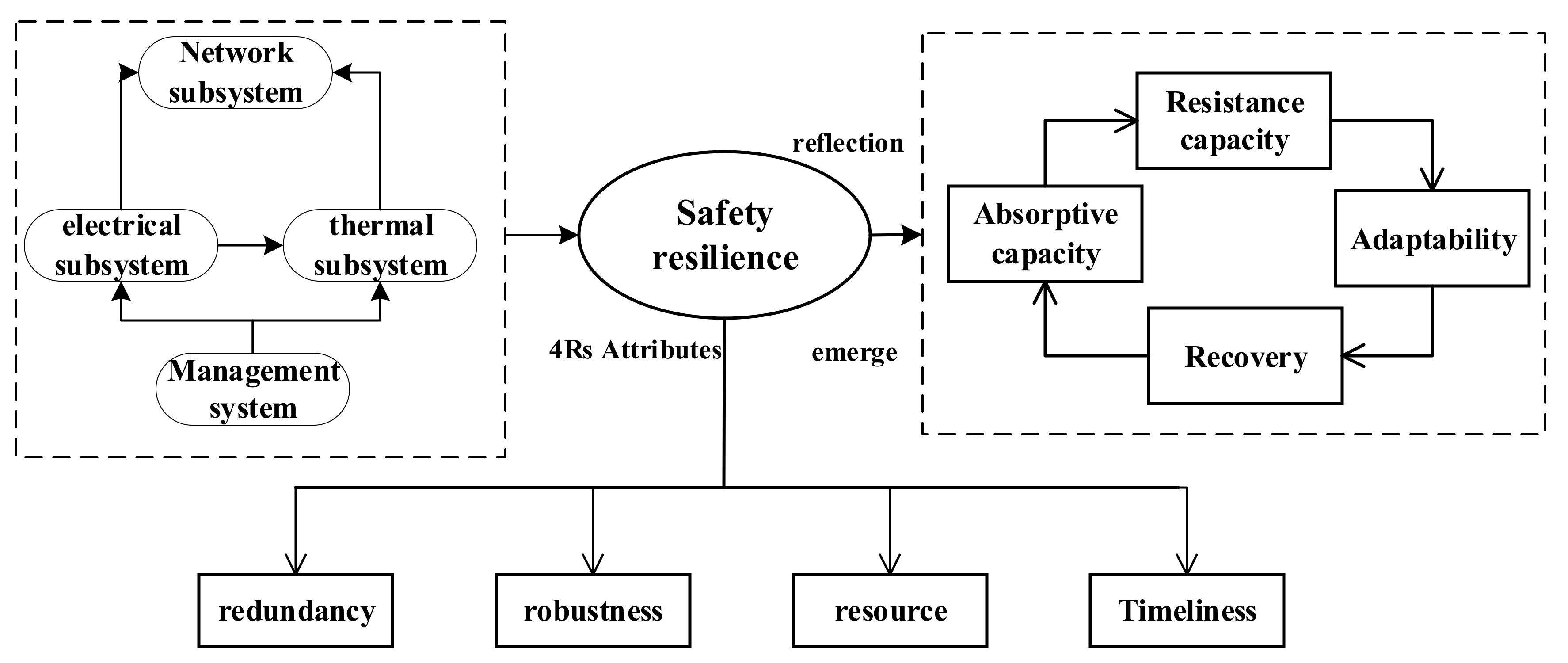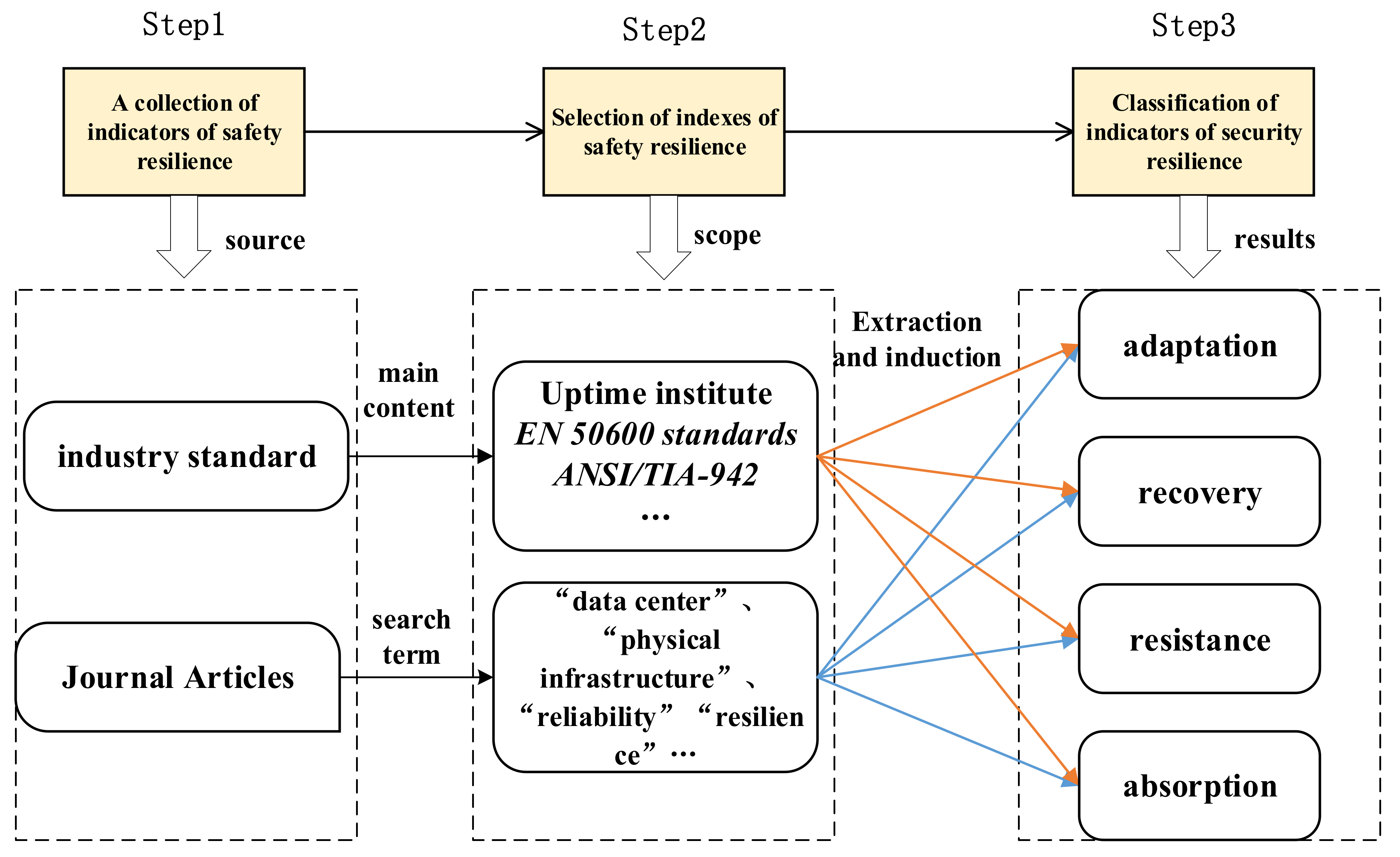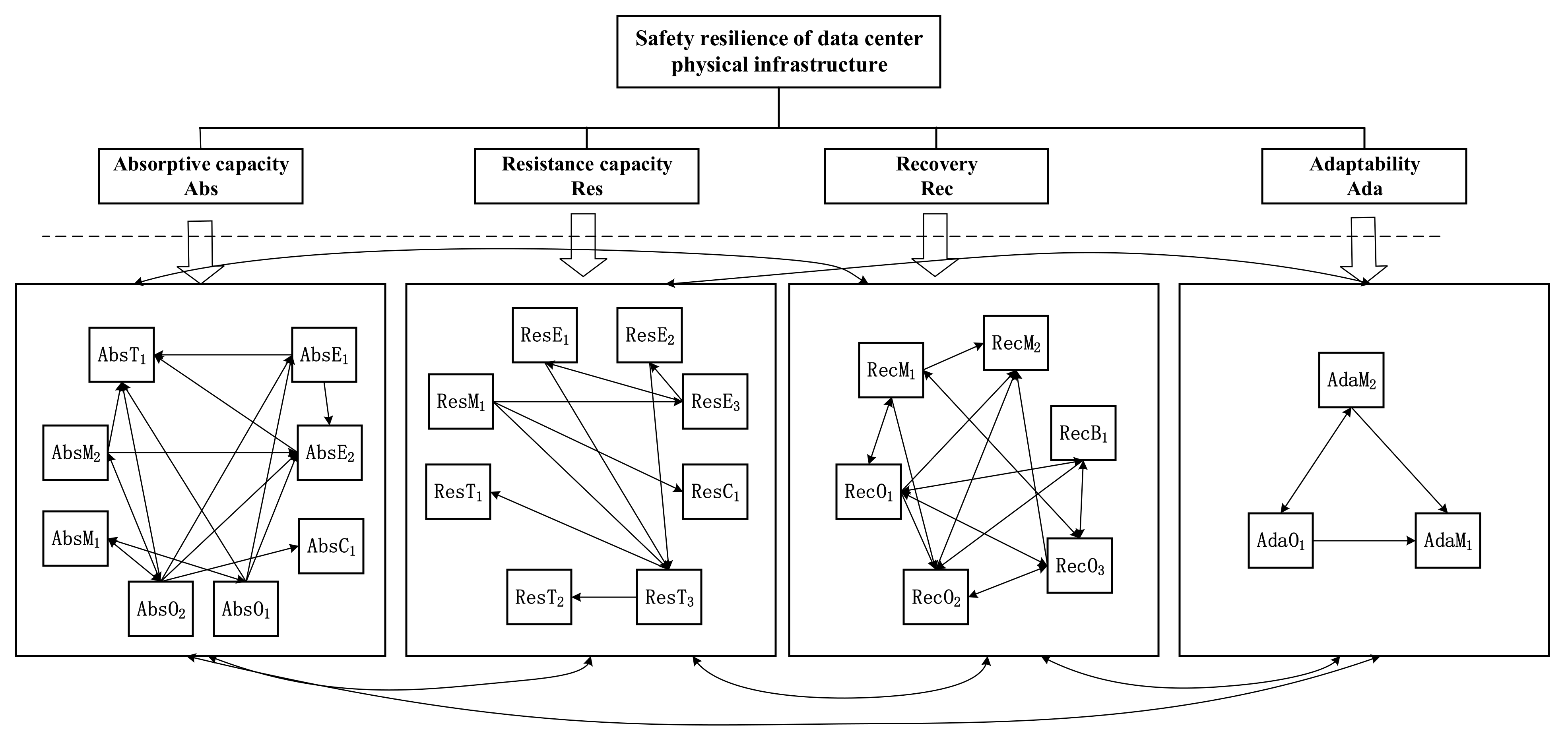Research on Safety Resilience Evaluation Model of Data Center Physical Infrastructure: An ANP-Based Approach
Abstract
1. Introduction
2. Literature Review
- (a)
- The current mainstream evaluation and certification systems are based on existing specifications and grades, focusing on reliability and availability, minimizing the occurrence of failures. However, little attention has been paid to the absorption, recovery, and adaptation after failure, and the current literature has failed to reach the understanding level of safety resilience.
- (b)
- The calculations about reliability and availability can only obtain a reliability value, but cannot measure the emergency, response, and recovery capabilities while facing failures. They heavily depend on historical data, which cannot be easily obtained.
- (c)
- The present research on resilience is mainly distributed into subsystems, and there is a lack of systematically comprehensive evaluation of the resilience of the overall infrastructure system integrating topology network and the operation and maintenance system.
3. Framework and Methods
3.1. Data Infrastructure Resilience Framework
3.2. Selection of Resilience Measurement Indexes and Establishment of Index System
3.3. Evaluation Index Model Based on ANP Method
- (a)
- Establish a structural hierarchy model: Establish a network relationship diagram according to the relationship between the factors of the control layer (objectives and criteria) and the network layer (indicators) by experts. Each relationship is identified by one-way or two-way arrows.
- (b)
- Construction of judgment matrix and determination of local priority: The expert group evaluates the pair-wise comparison matrix of the relationship between various factors according to the structural hierarchy model. After the judgment matrix results are obtained, the consistency test is carried out, and the check coefficient Cr is less than 0.1:In the formula, is the consistency index, is the maximum eigenvalue, is the order of judgment, and is the random consistency index.
- (c)
- Calculation of supermatrix: Take control layer element as the control criterion. The weight matrix is constructed based on the sub-criteria of each element in the element group . Then, the supermatrix under control criterion is obtained. After normalization, the weighted supermatrix and the convergent limit supermatrix are obtained:where represents the normalized eigenvector obtained by comparing each element in the element group , and represents the elements of the normalized weighting matrix of the factor group judgment matrix under the control criterion .
- (d)
- Calculation of group decision making: To ensure the accuracy of the result, the final result is calculated by the geometric average of the results of various experts. After calculating the geometric average value of each index, the final priority value can be obtained.
4. Index Identification and Weight Calculation
4.1. Setting Up an Index System
4.2. Element Influence Relationship and Weight Calculation Process
5. Results and Discussion
5.1. Results
5.2. Discussion
5.3. Implication
6. Conclusions
Author Contributions
Funding
Data Availability Statement
Conflicts of Interest
References
- Zhang, C.C.; Zhang, M.W.; Xiao, C.W. From traditional infrastructure to new infrastructure: A new focus of China’s Belt and Road Initiative diplomacy? Eurasian Geogr. Econ. 2022, 63, 424–443. [Google Scholar] [CrossRef]
- Fu, H.L.; Zhu, H.; Xue, P.D.; Hu, X.; Guo, X.T.; Liu, B.S. Eye-tracking study of public acceptance of 5G base stations in the context of the COVID-19 pandemic. Eng. Constr. Archit. Manag. 2022. ahead-of-print. [Google Scholar] [CrossRef]
- Wu, J.; Zhang, Y.J.; Shi, Z. Crafting a Sustainable Next Generation Infrastructure: Evaluation of China’s New Infrastructure Construction Policies. Sustainability 2021, 13, 6245. [Google Scholar] [CrossRef]
- Jiang, S.F.; Jiang, L. Enterprise Artificial Intelligence New Infrastructure Standardization and Intelligent Framework Design. In Proceedings of the 5th International Conference on IoT in Social, Mobile, Analytics and Cloud (I-SMAC), Palladam, India, 11–13 November 2021; pp. 555–558. [Google Scholar]
- Meng, J.Y.; Zhu, Y.T.; Han, Y. Can ‘new’ infrastructure become an engine of growth for the Chinese economy? J. Chin. Econ. Bus. Stud. 2022, 1–22. [Google Scholar] [CrossRef]
- Cheng, H.W.; Liu, B.; Lin, W.W.; Ma, Z.H.; Li, K.Q.; Hsu, C.H. A survey of energy-saving technologies in cloud data centers. J. Supercomput. 2021, 77, 13385–13420. [Google Scholar] [CrossRef]
- Garcia-Saiz, D.; Zorrilla, M.; Bosque, J.L. A clustering-based knowledge discovery process for data centre infrastructure management. J. Supercomput. 2017, 73, 215–226. [Google Scholar] [CrossRef]
- Colman-Meixner, C.; Develder, C.; Tornatore, M.; Mukherjee, B. A Survey on Resiliency Techniques in Cloud Computing Infrastructures and Applications. IEEE Commun. Surv. Tutor. 2016, 18, 2244–2281. [Google Scholar] [CrossRef]
- Matko, V.; Brezovec, B.; Milanovic, M. Intelligent Monitoring of Data Center Physical Infrastructure. Appl. Sci. 2019, 9, 4998. [Google Scholar] [CrossRef]
- Franke, U. IT service outage cost: Case study and implications for cyber insurance. Geneva Pap. Risk Insur.-Issues Pract. 2020, 45, 760–784. [Google Scholar] [CrossRef]
- Bennaceur, W.M.; Kloul, L. Formal models for safety and performance analysis of a data center system. Reliab. Eng. Syst. Saf. 2020, 193, 106643. [Google Scholar] [CrossRef]
- Fang, F.; Yu, X.F. Design and Implementation of Next-Generation Data Center Infrastructure. Appl. Mech. Mater. 2014, 513–517, 1316–1319. [Google Scholar] [CrossRef]
- Huang, J.; Chai, Z.; Zhu, H. Detecting anomalies in data center physical infrastructures using statistical approaches. In Proceedings of the International Seminar on Computer Science and Engineering Technology (SCSET), Shanghai, China, 17–18 December 2018. [Google Scholar]
- Nguyen, T.A.; Kim, D.S.; Park, J.S. Availability modeling and analysis of a data center for disaster tolerance. Future Gener. Comput. Syst. 2016, 56, 27–50. [Google Scholar] [CrossRef]
- Ahmed, K.M.U.; Alvarez, M.; Bollen, M.H.J. Reliability Analysis of Internal Power Supply Architecture of Data Centers in Terms of Power Losses. Electr. Power Syst. Res. 2021, 193, 107025. [Google Scholar] [CrossRef]
- Abadi, M.F.; Haghighat, F.; Nasiri, F. Data center maintenance: Applications and future research directions. Facilities 2020, 38, 691–714. [Google Scholar] [CrossRef]
- Liao, T.Y.; Hu, T.Y.; Ko, Y.N. A resilience optimization model for transportation networks under disasters. Nat. Hazards 2018, 93, 469–489. [Google Scholar] [CrossRef]
- Martins, J.B.; Carim, G.; Saurin, T.A.; Costella, M.F. Integrating Safety-I and Safety-II: Learning from failure and success in construction sites. Saf. Sci. 2022, 148, 105672. [Google Scholar] [CrossRef]
- Giunta, M. Sustainability and resilience in the rehabilitation of road infrastructures after an extreme event: An integrated approach. Balt. J. Road Bridge Eng. 2017, 12, 154–160. [Google Scholar] [CrossRef][Green Version]
- Mostafavi, A.; Inman, A. Exploratory analysis of the pathway towards operationalizing resilience in transportation infrastructure management. Built Environ. Proj. Asset Manag. 2011, 6, 106–118. [Google Scholar] [CrossRef]
- Schulz, A.; Zia, A.; Koliba, C. Adapting bridge infrastructure to climate change: Institutionalizing resilience in intergovernmental transportation planning processes in the Northeastern USA. Mitig. Adapt. Strateg. Glob. Change 2015, 22, 1–24. [Google Scholar] [CrossRef]
- Townend, P.; Clement, S.; Burdett, D.; Yang, R.Y.; Shaw, J.; Slater, B.; Xu, J. Improving Data Center Efficiency Through Holistic Scheduling in Kubernetes. In Proceedings of the 13th IEEE International Conference on Service-Oriented System Engineering (SOSE)/10th International Workshop on Joint Cloud Computing (JCC)/IEEE International Workshop on Cloud Computing in Robotic Systems (CCRS), San Francisco, CA, USA, 4–9 April 2019; pp. 156–166. [Google Scholar]
- Zhabelova, G.; Vesterlund, M.; Eschmann, S.; Berezovskaya, Y.; Vyatkin, V.; Flieller, D. A Comprehensive Model of Data Center: From CPU to Cooling Tower. IEEE Access 2018, 6, 61254–61266. [Google Scholar] [CrossRef]
- Wiboonrat, M. Distribution Control Systems for Data Center. In Proceedings of the 8th IEEE/SICE International Symposium on System Integration (SII), Nagoya, Japan, 11–13 December 2015; pp. 789–794. [Google Scholar]
- Reddy, V.D.; Setz, B.; Subrahmanya, G.; Rao, V.R.K.; Gangadharan, G.R.; Aiello, M. Metrics for Sustainable Data Centers. IEEE Trans. Sustain. Comput. 2017, 2, 290–303. [Google Scholar] [CrossRef]
- Chen, G.; Zhao, Y.J.; Xu, H.L.; Pei, D.; Li, D. F2Tree: Rapid Failure Recovery for Routing in Production Data Center Networks. IEEE-ACM Trans. Netw. 2017, 25, 1940–1953. [Google Scholar] [CrossRef]
- Dong, Z.Y.; Zhang, L. A Comprehensive Security Strategy Applying to the Total Life Cycle of Cloud Computing Data Center. In Proceedings of the International Conference on Mechatronics Engineering and Computing Technology (ICMECT), Shanghai, China, 9–10 April 2014; pp. 6259–6261. [Google Scholar]
- Graefe, G. Instant recovery for data center savings. Sigmod Rec. 2015, 44, 29–34. [Google Scholar] [CrossRef]
- Somasekaram, P.; Calinescu, R.; Buyya, R. High-availability clusters: A taxonomy, survey, and future directions. J. Syst. Softw. 2022, 187, 111208. [Google Scholar] [CrossRef]
- Ahmed, K.M.U.; Bollen, M.H.J.; Alvarez, M. A Review of Data Centers Energy Consumption and Reliability Modeling. IEEE Access 2021, 9, 152536–152563. [Google Scholar] [CrossRef]
- Arno, R.; Friedl, A.; Gross, P.; Schuerger, R.J. Reliability of Data Centers by Tier Classification. IEEE Trans. Ind. Appl. 2012, 48, 777–783. [Google Scholar] [CrossRef]
- Melo, F.F.L.; Sousa, E.T.G.; Callou, G.R.A. Sensitivity Analysis of Data Center Electrical Infrastructures Considering Aspects of Dependability and Cost. IEEE Lat. Am. Trans. 2021, 19, 235–242. [Google Scholar] [CrossRef]
- Rocha, E.; Santos, G.L.; Endo, P.T. Analyzing the impact of power subsystem failures and checkpoint mechanisms on availability of cloud applications. IEEE Lat. Am. Trans. 2020, 18, 138–146. [Google Scholar] [CrossRef]
- Dionise, T.J.; Cooper, C.L. Data center reliability identifying issues that adversely affect electrical system audits. IEEE Ind. Appl. Mag. 2012, 18, 69–77. [Google Scholar] [CrossRef]
- Ahmed, K.M.U.; Alvarez, M.; Bollen, M.H.J. A Novel Reliability Index to Assess the Computational Resource Adequacy in Data Centers. IEEE Access 2021, 9, 54530–54541. [Google Scholar] [CrossRef]
- Parise, G.; Allegri, M.; Parise, L. Electrical Integrity Resilience of Data Centers and Critical Loads. IEEE Trans. Ind. Appl. 2020, 56, 3397–3402. [Google Scholar] [CrossRef]
- Cheung, H.; Wang, S. Reliability and availability assessment and enhancement of water-cooled multi-chiller cooling systems for data centers. Reliab. Eng. Syst. Saf. 2019, 191, 106573. [Google Scholar] [CrossRef]
- Lin, M.; Shao, S.Q.; Zhang, X.H.; VanGilder, J.W.; Avelar, V.; Hu, X.P. Strategies for data center temperature control during a cooling system outage. Energy Build. 2014, 73, 146–152. [Google Scholar] [CrossRef]
- Cho, J.; Park, B.; Jeong, Y. Thermal Performance Evaluation of a Data Center Cooling System under Fault Conditions. Energies 2019, 12, 2996. [Google Scholar] [CrossRef]
- Matko, V.; Brezovec, B. Improved Data Center Energy Efficiency and Availability with Multilayer Node Event Processing. Energies 2018, 11, 2478. [Google Scholar] [CrossRef]
- Rocha, E.D.; da Silva, L.G.F.; Santos, G.L.; Bezerra, D.; Moreira, A.; Goncalves, G.; Marquezini, M.V.; Mehta, A.; Wildeman, M.; Kelner, J.; et al. Aggregating data center measurements for availability analysis. Softw. Pract. Exp. 2021, 51, 868–892. [Google Scholar] [CrossRef]
- Ricci, P.P.; Donatelli, M.; Onofri, M.; Scarponi, L.B.; Velardo, A. An innovative monitoring and maintenance model for the INFN CNAF Tier-1 data center infrastructure. In Proceedings of the 19th International Workshop on Advanced Computing and Analysis Techniques in Physics Research (ACAT), Saas Fee, Switzerland, 11–15 March 2019; Publishing, I.O.P: Bristol, UK, 2019. [Google Scholar]
- Folke, C. Resilience: The emergence of a perspective for social–ecological systems analyses. Glob. Environ. Chang. 2006, 16, 253–267. [Google Scholar] [CrossRef]
- Bruneau, M.; Chang, S.E.; Eguchi, R.T.; Lee, G.C.; O’Rourke, T.D.; Reinhorn, A.M.; Shinozuka, M.; Tierney, K.; Wallace, W.A.; von Winterfeldt, D. A framework to quantitatively assess and enhance the seismic resilience of communities. Earthq. Spectra 2003, 19, 733–752. [Google Scholar] [CrossRef]
- Vugrin, E.D.; Warren, D.E.; Ehlen, M.A.; Camphouse, R.C. A Framework for Assessing the Resilience of Infrastructure and Economic Systems. In Sustainable and Resilient Critical Infrastructure Systems; Springer: Berlin/Heidelberg, Germany, 2010. [Google Scholar]
- Francis, R.; Bekera, B. A metric and frameworks for resilience analysis of engineered and infrastructure systems. Reliab. Eng. Syst. Saf. 2014, 121, 90–103. [Google Scholar] [CrossRef]
- Xu, Z.; Tian, J.; Zhang, J. Urban resilience evaluation system and optimization strategy from perspective of disaster prevention. China Saf. Sci. J. 2019, 29, 1–7. [Google Scholar]
- Zhang, C.L.; Oh, J.; Park, K. Evaluation of sewer network resilience index under the perspective of ground collapse prevention. Water Sci. Technol. 2022, 85, 188–205. [Google Scholar] [CrossRef] [PubMed]
- Feofilovs, M.; Romagnoli, F. Dynamic assessment of urban resilience to natural hazards. Int. J. Disaster Risk Reduct. 2021, 62, 102328. [Google Scholar] [CrossRef]
- Qiao, W.L.; Ma, X.X.; Liu, Y.; Lan, H. Resilience Assessment for the Northern Sea Route Based on a Fuzzy Bayesian Network. Appl. Sci. 2021, 11, 3619. [Google Scholar] [CrossRef]
- Xiahou, X.E.; Wu, Y.F.; Duan, T.L.; Lin, P.; Li, F.N.; Qu, X.J.; Liu, L.; Li, Q.M.; Liu, J.X. Analyzing Critical Factors for the Smart Construction Site Development: A dematel-ISM based approach. Buildings 2022, 12, 116. [Google Scholar] [CrossRef]
- Luo, X.; Liu, H.; Zhao, X.; Mao, P. Managing the additional cost of passive buildings from the supply chain perspective: A case of Nanjing, China. Build. Environ. 2022, 222, 109351. [Google Scholar] [CrossRef]
- Wang, F.; Magoua, J.J.; Li, N.; Fang, D.P. Assessing the impact of systemic heterogeneity on failure propagation across interdependent critical infrastructure systems. Int. J. Disaster Risk Reduct. 2020, 50, 101818. [Google Scholar] [CrossRef]
- Guo, Q.J.; Amin, S.; Hao, Q.W.; Haas, O. Resilience assessment of safety system at subway construction sites applying analytic network process and extension cloud models. Reliab. Eng. Syst. Saf. 2020, 201, 106956. [Google Scholar] [CrossRef]
- Xu, H.; Li, Y.; Wang, L. Resilience Assessment of Complex Urban Public Spaces. Int. J. Environ. Res. Public Health 2020, 17, 524. [Google Scholar] [CrossRef]
- He, Z.; Chen, H.H.; Yan, H.Y.; Yin, Y.; Qiu, Q.; Wang, T.P. Scenario-Based Comprehensive Assessment for Community Resilience Adapted to Fire Following an Earthquake, Implementing the Analytic Network Process and Preference Ranking Organization Method for Enriched Evaluation II Techniques. Buildings 2021, 11, 523. [Google Scholar] [CrossRef]
- Wang, L.; Xue, X.L.; Wang, Z.Y.; Zhang, L.S. A Unified Assessment Approach for Urban Infrastructure Sustainability and Resilience. Adv. Civ. Eng. 2018, 2018, 2073968. [Google Scholar] [CrossRef]
- Xu, W.P.; Cong, J.T.; Proverbs, D.; Zhang, L.L. An Evaluation of Urban Resilience to Flooding. Water 2021, 13, 2022. [Google Scholar] [CrossRef]
- Chou, J.S.; Ongkowijoyo, C.S. Hybrid decision-making method for assessing interdependency and priority of critical infrastructure. Int. J. Disaster Risk Reduct. 2019, 39, 101134. [Google Scholar] [CrossRef]
- Bin Zhu, H.; Cheng, J.; Li, X.M.; Shan, S. A New Comprehensive Method of Evaluating Data Center. In Proceedings of the 8th International Conference on Computing and Networking Technology (ICCNT), Gueongju, Korea, 27–29 August 2012; pp. 81–85. [Google Scholar]
- Parise, G.; Parise, L. Electrical Distribution for a Reliable Data Center. IEEE Trans. Ind. Appl. 2013, 49, 1697–1702. [Google Scholar] [CrossRef]




| Resilience Characterization | Subsystem | Specific Manifestations | Extraction of Indicators | Coding |
|---|---|---|---|---|
| Absorptive capacity | Electrical Subsystem | Coordination of ground fault protection, lightning protection grounding, surge current, and protection. | Stability and reliability of electrical system protection | AbsE1 |
| UPS input power distribution, UPS output power distribution, load rack row power distribution (pillar cabinet), rack power distribution. | Stability and reliability of electrical distribution system | AbsE2 | ||
| Thermal Subsystem | Keeping data center infrastructure temperature stable with water cooling, airflow cooling. | Temperature control stability | AbsT1 | |
| Management and Control Subsystem | Through the tracking information monitoring and management platform, the data are analyzed to identify and predict risks and deal with them. | Failure risk prediction and early warning | AbsM1 | |
| The process of ensuring that the maximum load is not exceeded to ensure adequate capacity during normal and emergency operation. | Scalability management of capacity and load | AbsM2 | ||
| Cabling Subsystem | Reasonable wiring reduces possible unexpected failures, reduces wind resistance, etc. | Specification and stability of cabling system | AbsC1 | |
| Organization and Operation System | Personnel includes the number of full-time personnel, institutions, personnel qualifications, personnel communication mechanisms, etc. | Normative management of personnel organizations | AbsO1 | |
| Predictive maintenance planning, including delayed maintenance planning, evaluation of repairs, modifications, and redesign of system components. | Completeness of daily maintenance management system | AbsO2 | ||
| Resistance capacity | Electrical Subsystem | Redundant components ensure switchover and functional assurance in the event of component failure, including backup power system UPS, diesel generators, and energy fuel. | Redundant capacity component of the electrical system | ResE1 |
| Features redundant circuit distribution paths that switch in the event of a failure to ensure stable operation. | Multiple independent circuit distribution paths of the electrical system | ResE2 | ||
| Including dynamic power transfer switch and static power transfer switch, which can convert power supply in case of failure, which can be divided into PC-level ATSE and CB-level ATSE. | Power transfer switch | ResE3 | ||
| Management and Control Subsystem | Comprehensive and real-time data monitoring; accurate and comprehensive fault detection. | Real-time data and fault monitoring capability | ResM1 | |
| Cabling Subsystem | There is a redundant line emergency in case of line failure, and the compatibility between lines ensures normal conversion. | Redundancy and compatibility of cabling system | ResC1 | |
| Thermal Subsystem | The equipment capacity components of the cooling system have a certain degree of redundancy, such as energy storage devices, coolers, cooling devices, pumps, cooling devices, and fuel tanks. | redundant capacity Components of the thermal system | ResT1 | |
| The distribution path wiring of the cooling system has some redundancy and can be replaced in the event of a failure. | Multiple independent distribution paths of the thermal system | ResT2 | ||
| Use thermal storage equipment to survive cooler restart times or connect cooling equipment to backup power to maintain adequate backup cooling capacity. | Temperature control and standby energy during downtime | ResT3 | ||
| Recovery | Management and Control Subsystem | An efficient process for identifying failure issues with accurate reasoning through data anomalies, identifying root causes, and implementing corrective actions. | Fault monitoring, identification, and reasoning ability | RecM1 |
| Organization and Operation System | Maintenance list management of installed equipment, special tools, historical data critical spare parts, and reorder points will effectively improve repair performance. | Daily emergency maintenance management system | RecO1 | |
| Equipped with sufficient and comprehensive emergency management professionals to improve emergency response capabilities through appropriate training to achieve rapid response and effective maintenance. | Organization and reflection ability of emergency personnel | RecO2 | ||
| Quick and effective response through the emergency management system and plan. | Emergency management drill and response | RecO3 | ||
| Building Subsystem | Provide sufficient space for maintenance facilities to remove and replace infrastructure equipment safely and quickly. | Effective maintenance space | RecB1 | |
| Adaptability | Management and Control Subsystem | Update and upgrade system equipment according to interruptions, and adjust resource allocation capabilities. | System update and resource allocation capability adjustment | AdaM1 |
| Record and process the interruption cause and related data to improve the ability to cope with the next interruption. | Historical fault data recording and management | AdaM2 | ||
| Organization and Operation System | Accident cause investigation, experience summarization, rectification implementation, and feedback from the operating organization, including records of data, time, root cause analysis, and lessons learned. | Accident summary management system | AdaO1 |
| Reference Index | i | j | k |
|---|---|---|---|
| i | - | - | |
| j | - | ||
| k |
| Serial Number | Grade of Importance | Cij Valuation |
|---|---|---|
| 1 | i is equally as important as j | 1 |
| 2 | i is equally to moderately more important than j | 2 |
| 3 | i is moderately more important than j | 3 |
| 4 | i is moderately to strongly more important than j | 4 |
| 5 | i is strongly more important than j | 5 |
| 6 | i is strongly to very strongly more important than j | 6 |
| 7 | i is very strongly more important than j | 7 |
| 8 | i is very strongly to extremely more important than j | 8 |
| 9 | i is extremely more important than j | 9 |
| Cluster | Name | Extraction of Influencing Factors | Limiting | Order | Total Weight |
|---|---|---|---|---|---|
| Absorptive capacity | AbsC1 | Standardization and stability of cabling system | 0.0000284 | 24 | 0.1306677 |
| AbsE1 | Stability and reliability of electrical system protection | 0.0009553 | 22 | ||
| AbsE2 | Stability and reliability of electrical distribution system | 0.0451186 | 12 | ||
| AbsM1 | Failure risk prediction and early warning | 0.0235201 | 16 | ||
| AbsM2 | Scalability management of capacity and load | 0.0073653 | 19 | ||
| AbsO1 | Normative management of personnel organizations | 0.0004921 | 23 | ||
| AbsO2 | Completeness of daily maintenance management system | 0.0068701 | 20 | ||
| AbsT1 | Temperature control stability | 0.0463178 | 11 | ||
| Resistance capacity | ResC1 | Redundancy and compatibility of cabling system | 0.0061931 | 21 | 0.4596134 |
| ResE1 | Redundant capacity component of the electrical system | 0.0554016 | 9 | ||
| ResE2 | Multiple independent circuit distribution paths of the electrical system | 0.0658952 | 7 | ||
| ResE3 | Power transfer switch | 0.0303343 | 14 | ||
| ResM1 | Real-time data and fault monitoring capability | 0.069567 | 4 | ||
| ResT1 | Redundant capacity components of the thermal system | 0.0612428 | 8 | ||
| ResT2 | Multiple independent distribution paths of the thermal system | 0.0721339 | 3 | ||
| ResT3 | Temperature control and standby energy during downtime | 0.0988455 | 2 | ||
| Recovery | RecB1 | Effective maintenance space | 0.0247241 | 15 | 0.1682657 |
| RecM1 | Fault monitoring, identification, and reasoning ability | 0.0377209 | 13 | ||
| RecO1 | Daily emergency maintenance management system | 0.0191796 | 17 | ||
| RecO2 | Organization and reflection ability of emergency personnel | 0.0186977 | 18 | ||
| RecO3 | Emergency management drill and response | 0.0679434 | 5 | ||
| Adaptability | AdaM1 | System update and resource allocation capability adjustment | 0.1188934 | 1 | 0.2414529 |
| AdaM2 | Historical fault data recording and management | 0.0548175 | 10 | ||
| AdaO1 | Accident summary management system | 0.067742 | 6 |
Publisher’s Note: MDPI stays neutral with regard to jurisdictional claims in published maps and institutional affiliations. |
© 2022 by the authors. Licensee MDPI, Basel, Switzerland. This article is an open access article distributed under the terms and conditions of the Creative Commons Attribution (CC BY) license (https://creativecommons.org/licenses/by/4.0/).
Share and Cite
Xiahou, X.; Chen, J.; Zhao, B.; Yan, Z.; Cui, P.; Li, Q.; Yu, Z. Research on Safety Resilience Evaluation Model of Data Center Physical Infrastructure: An ANP-Based Approach. Buildings 2022, 12, 1911. https://doi.org/10.3390/buildings12111911
Xiahou X, Chen J, Zhao B, Yan Z, Cui P, Li Q, Yu Z. Research on Safety Resilience Evaluation Model of Data Center Physical Infrastructure: An ANP-Based Approach. Buildings. 2022; 12(11):1911. https://doi.org/10.3390/buildings12111911
Chicago/Turabian StyleXiahou, Xiaer, Jialong Chen, Bangyi Zhao, Zixuan Yan, Peng Cui, Qiming Li, and Zhou Yu. 2022. "Research on Safety Resilience Evaluation Model of Data Center Physical Infrastructure: An ANP-Based Approach" Buildings 12, no. 11: 1911. https://doi.org/10.3390/buildings12111911
APA StyleXiahou, X., Chen, J., Zhao, B., Yan, Z., Cui, P., Li, Q., & Yu, Z. (2022). Research on Safety Resilience Evaluation Model of Data Center Physical Infrastructure: An ANP-Based Approach. Buildings, 12(11), 1911. https://doi.org/10.3390/buildings12111911











